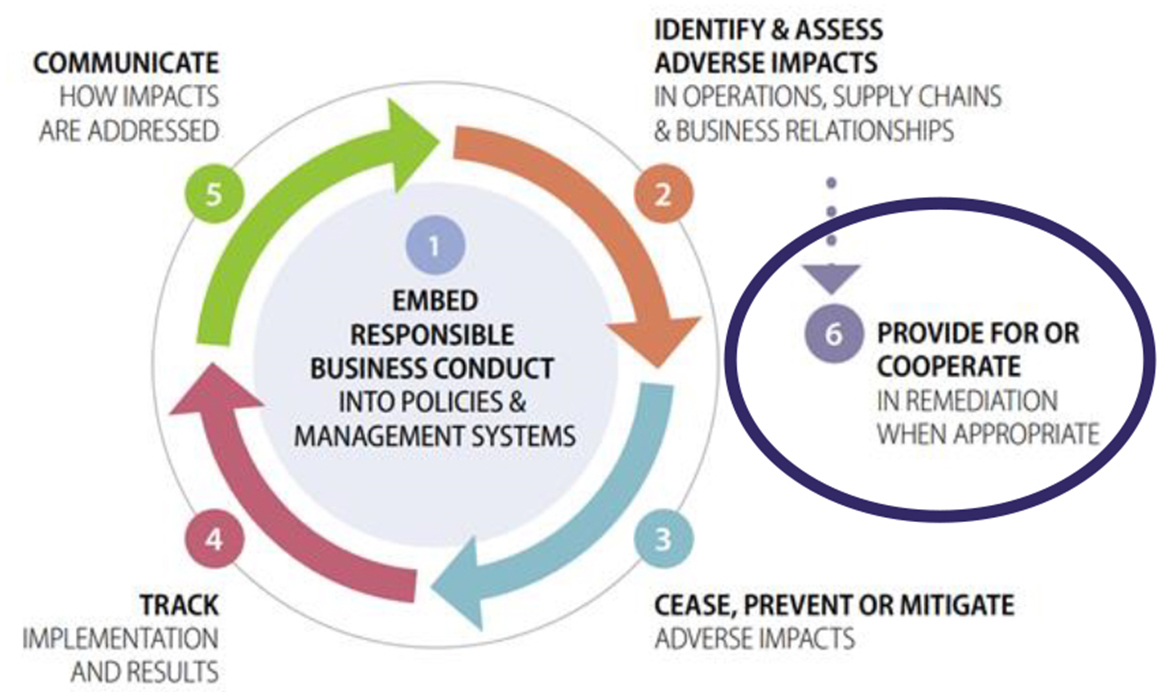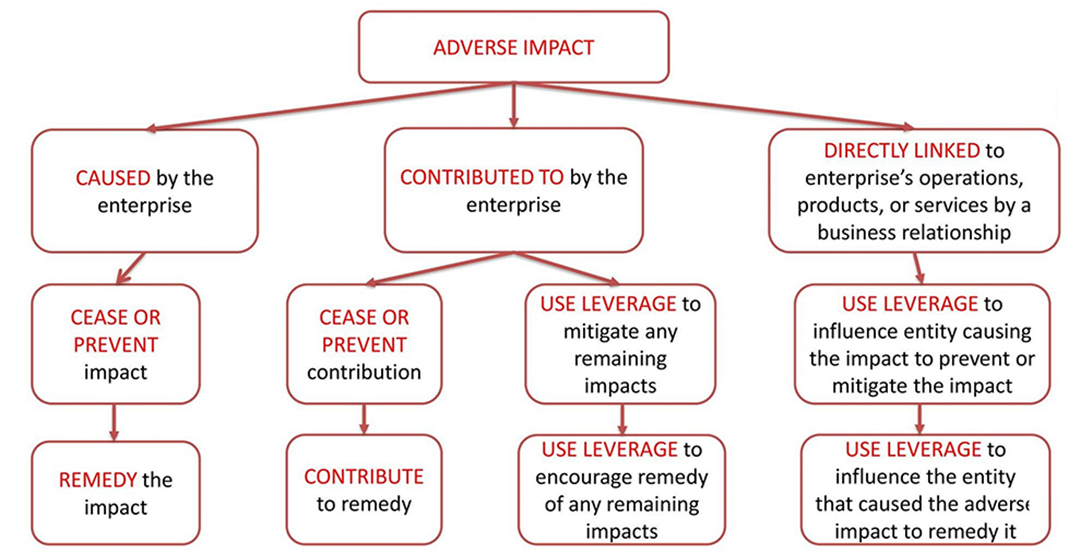Access to Remedy
The UN Guiding Principles and the OECD Guidelines prescribe that States take appropriate actions to ensure those harmed by corporate actions or omissions, have access to effective remedy. Depending on their specific connection to the harm in question, companies have various forms of responsibilities to (help) alleviate the harm. Access to remedy therefore concerns both governments and companies.
Occupational hazards, worker exploitation, child labor and the destruction of critical natural ecosystems are prevalent in the supply chains of many companies. Such severe harm to people and the natural environment can be a result of actions or omissions of one or more actors in the concerned supply chain.
We would like to contribute to the development of a well-functioning and effective mechanism that offers rightsholders in supply chains access to remedy. We aim to do it through our accumulated knowledge, expertise and network. RBC is not only about preventing and mitigating risks, but also remedying the harm caused.
- What is access to remedy?
- What is a grievance mechanism?
- When should a company remediate negative impacts?
- Who can potential victims contact?
- What does the SER do with regard to access to remedy?
What is access to remedy?
For companies, access to remedy is part of the due diligence process, namely step 6: ‘Provide for or cooperate in remediation’. It concerns providing the opportunity for victims of abuse to seek redress from a company that caused or contributed to the abuse. The SER provides an extensive manual that helps companies to practically fill in step 6 of the due diligence process.

Access to effective remedy has both procedural and substantive aspects. On one hand, it means that companies need to have effective and impartial procedures for the provision of remedy. On the other hand, this also means that the victims of abuse need to be able to get a substantive remedy through these procedures. Remedies may take a range of substantive forms, such as apologies, restitution, rehabilitation, financial or non-financial compensation, punitive sanctions, as well as the prevention of harm through, for example, injunctions or guarantees of non-repetition. Depending on the situation, a range of remedies may also be relevant.
What is a grievance mechanism?
A grievance mechanism is a process through which grievances concerning business-related human rights abuse can be raised and remedy can be sought. UNGPs require business enterprises to establish or participate in effective operational-level grievance mechanisms. Operational-level grievance mechanisms are those grievance mechanisms which are accessible directly to individuals and communities who may be adversely impacted by a business enterprise. They are typically administered by companies alone or in collaboration with others, including relevant stakeholders. They may also be provided through recourse to a mutually acceptable external expert or body. They do not require that those bringing a complaint first access other means of recourse. They can engage the business enterprise directly in assessing the issues and seeking remediation of any harm.
Operational-level grievance mechanisms need to meet the following effectiveness criteria, established by UNGPs:
- Legitimacy
- Accessibility
- Predictability
- Equitability
- Transparency
- Rights-compatibility
- Being a source of continuous learning
- Being based on engagement and dialogue.
When should a company remediate negative impacts?
The extent to which companies need to take action to address negative impacts, depends on the degree of their involvement. Companies that actually caused the adverse impact need to also remedy the harm that has occurred. For instance, think of a company that itself discharges toxic substances into a river or a company that knows that the security company it hires is using excessive force.
Companies which contributed to adverse impacts must contribute to the remedy to the extent of their contribution. Companies can contribute to harm, for example, by setting an unrealistic deadline for an order, so that employees are forced to work unhealthy overtime.
The third category consists of companies that are ‘directly linked’ to an abuse. This means that the harm occurs somewhere in a company’s supply chain. When a company discovers this, it should use its influence to limit and prevent the adverse impact. For example, it can, acting alone or together with other companies in the sector and / or civil society organisations, send a letter to the supplier that violates the OECD Guidelines to persuade the latter to correct the adverse impact caused.

Who can potential victims contact?
In the first place, all companies are expected to have an early warning system in place through which they can be informed of negative impacts in their own operations or supply chains. Such early warning systems can also be part of an effective grievance mechanism established by the company or of which it is a part of. Companies are expected to enter into dialogue with relevant stakeholders to resolve such issues.
In an ideal world, the governments in production countries would have effective (judicial and non-judicial) systems in place locally for settling business and human rights related disputes. However, this is not always the case. That is why every country that adheres to the OECD Guidelines is expected to have a well-resourced National Contact Point (NCP), which is responsible for handling enquiries and contributing to the resolution of conflicts rising from the conduct of companies.
NCPs handle specific complaints about companies that do not adhere to the OECD Guidelines and fall within the jurisdiction of an OECD adhering country. They are independent, state-based non-judicial bodies, that facilitate mediation between the complainant and the company in question. The procedure is accessible and cheap, because no lawyers are needed. That is an advantage for the victims.
The main goal of mediation is to find a solution that is acceptable to both parties and that prevents reputation damage and escalation. The NCPs cannot impose formal sanctions or force the cooperation of companies. In a final statement, it makes recommendations to a company in situations where no agreement was reached during mediation. It can propose remedies which a company needs to provide if found to have not acted in accordance with the OECD Guidelines. The procedure is, in principle, confidential which means that it does not immediately end up on the front page of the newspaper. The recommendations, however, are public.
National court systems, National Human Rights Institutions and multi-stakeholder grievance mechanisms can also be used by victims to claim remediation for harm caused by companies.
What does the SER do with regard to access to remedy?
In the advisory report “Effectieve Europese gepaste zorgvuldigheidswetgeving voor duurzame ketens” (2021), the SER advises companies to join a recognized independent grievance mechanism (individual or collective) that can make binding decisions. These mechanisms can build on the lessons of existing mechanisms. Experience has been gained with two RBC Agreements with joint grievance mechanisms that should provide access to remedy: the Agreement on Sustainable Garments and Textile and the Flemish-Dutch Initiative TruStone. In the advisory report from 2021, the SER also recommends setting up a collective grievancemechanism at European level for sectors that do not yet have a mechanism.
The SER is independent and from that position wants to further explore the virtually unexplored territory of a cross-sector mechanism for complaints and disputes and build step by step towards a situation in which anyone who signals abuse in a production chain can submit a complaint about it. A study is currently underway into the feasibility of cooperation between grievance mechanisms in production countries and in Europe. The SER is also exploring creating a network for companies to learn from each other, strengthen their influence together and share their best practices on enabling access to remedy in the chain.
Together with its partners, over the years, SER has organized several webinars and online sessions on access to remedy in practice and also developed a range of tools that can help companies improve access to remedy in their operations and supply chain.
More information
Do you have a question about access to remedy? Please contact Seljan Verdiyeva-Smeets s.verdiyeva@ser.nl.
